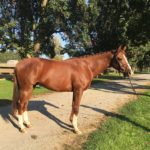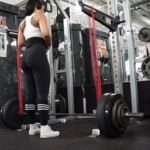Again the disclaimer that this is my somewhat-educated opinion on the subject only.
Before I started riding with Jenn, she had made the decision to take her horses out of steel shoes and put them into EasyBoots for riding. ?She freely admits that there?isn’t?any substantial financial incentive – keeping an endurance horse going in boots is costly because they put so many miles on their feet.? And, honestly, boots can be a giant pain in the rear.? But I have seen two of her horses become substantially sounder and more reliable as a direct result of being barefoot and in boots instead of continuously wearing steel shoes.
Bear, in particular, is a changed beast in EasyBoots.? He was an infamous tripper in steel shoes, truly frightening to ride.? Once he’d transitioned to barefoot with boots for conditioning and racing, he discovered a new appreciation for putting his feet down carefully.? Jenn theorizes that he’d been in steel shoes for so long that he really had no sensation in his front feet.

It didn’t completely solve his tripping tendencies, though, and I was still racing him holding my breath.? Then before Tevis in 2012, the EasyBoot guys evaluated Bear’s hooves and recommended that he go up a ? size in boots.? ?A horse’s hooves expand/become larger over time out of steel shoes.? Jenn followed their recommendation and – I really want to knock on wood here – Bear stopped tripping.? He didn’t stumble at all during that Tevis and for the remainder of the 2012 race season he was a rewardingly upright animal to sit on top of.
I pontificate here about riding in boots from a pretty cushy seat.? Jenn carries the entire burden for keeping her horses going in this way.? We do most of our conditioning rides in EasyBoot Gloves – this is a small, tight-fitting rubber boot that fits snugly over the hoof and is additionally secured by a soft, neoprene gaiter that Velcros around the fetlock.? Jenn maintains an enormous collection of Gloves – which cost close to $70 each – and keeps track of what size fits where on which horse (at least one of them wears three different sizes on four hooves).
We carry back-up Gloves in our saddle packs when we ride because it is possible to completely destroy a boot or eject it irretrievably into the wilderness.? Each hoof is wrapped in vet wrap or athletic tape (whatever we have handy) before the boot is put on to create better grip/fit between the two.
Enemies of boots include water, mud and steep terrain.? We spend a good bit of time riding through and over all three of those, especially in the spring.? So the average spring-time conditioning ride involves several stops for boot retrieval/re-application.
Racing requires glue-ons. ?EasyBoot Glue-ons are essentially the same small rubber boot involved in the Glove, but without a gaiter.? Two kinds of industrial glue are used to bond the boot to the hoof.
I love riding in glue ons.? I rode many years on many horses in steel shoes, and I?wouldn’t?say that it is a terrible way to go.? I did Tevis successfully several times on horses wearing steel shoes with no pads (a pad can be added between shoe and hoof to help protect from rocky terrain).? But riding in glue-ons makes me feel super human.? You can ride at speed over small-rock terrain with impunity.? A horse in steel shoes, even with pads, would most likely be courting stone bruise disaster, but the boot provides nearly impervious protection.
I must give props to Jenn here, not just for her decision to put the horses in boots and her investment of both time and money in making it possible, but also for her expert ability to apply glue-ons.? It’s a messy, epoch task and she’s nearly perfected her skill at it.
Check out her blog on the EasyCare website http://blog.easycareinc.com/blog/the-trailhead/the-other-barefoot-wine-company.







